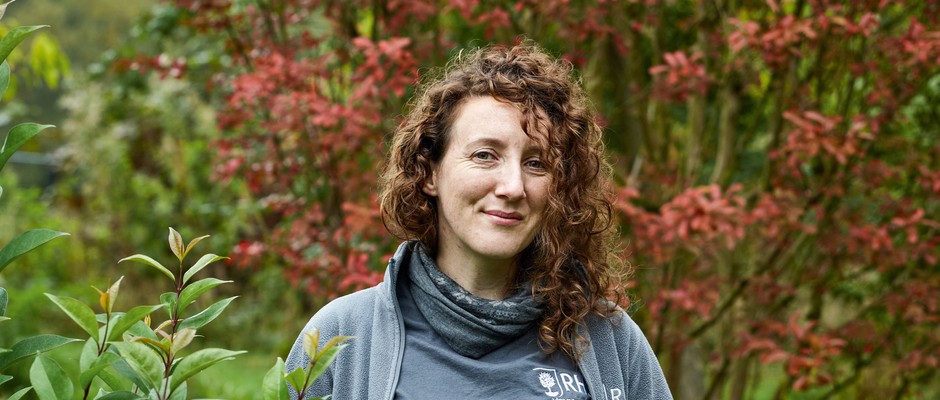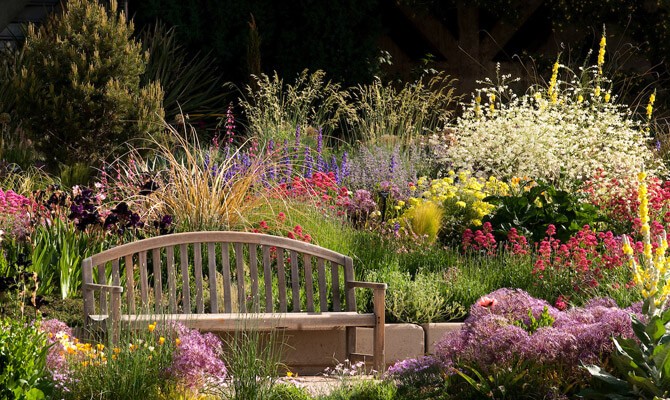
Helen Watts: we should view our gardens as a living, breathing ecosystem
From maintaining ornamentals to developing more natural areas, Helen’s role as an RHS Garden Bridgewater horticulturist envelops a range of skills
Earliest garden/gardening memory: Not quite a garden memory but my earliest plant memories were raspberry picking with my mother as she occasionally worked the fruit season. Turns out 1980s small farms in Kent had a more relaxed attitude for bringing your kids to work. My first memories were eating the berries, being chased by bees and running around apple trees.
First plant love: From living in Fiordland national park, New Zealand, this was the turning point for me falling in love with plants. My first plant love remains the native Dicksonia antarctica ferns inhabiting the lush rainforests. The sheer age, size and number of these giants inspired me to find my way into horticulture.
What did you do before you became a gardener? I joined the workforce after university in the financial crisis, where working in local government in communications was enough to see life at a desk was not for me. I then left the country for five years, working in adventure tourism across Australasia and traveling. It was during this time I ended up knowing I wanted to work with plants and the UK would be the best place to train to do this.
Favourite landscape and garden that has influenced you: Temperate rainforests and wetlands are my main inspiration, especially when nature begins to overtake human made structures. Angkor Wat remains a favourite landscape. Garden wise Inverewe is at the top of the list. It’s an incredible garden on the edge of the North West Scotland combining human achievement and a jaw dropping natural environment. Due to its unique micro climate caused by the Gulf Stream hitting the highland coast, exotic plants have been able to flourish. It’s a truly special place but keep moving in midge season!
Three most worthwhile tips for every gardener:
• If you’re developing an area, try not to leave exposed bare soil. This is not healthy and if you have any, don’t get cross with pioneer plants like docks when they crop up. They are just doing what nature intended. If you’re not doing work for a season, mulch with a green mulch to improve the soil and give surprising interest. I’m a big fan of phacelia (and so are the bees).
• A garden is more than 2D visual aesthetics. View your garden as a living, breathing ecosystem whether your garden is fully ornamental or growing food. When planning your garden, think about how you are going to invite birds into your areas so their song can be heard, making a home for pollinators and what aromas you want from a garden.
• Leaving herbaceous plants’ dead foliage over winter is the kindest thing you can do for wildlife and your soil. A lot of the seed heads make excellent winter features, especially in the frost. If we didn’t have such a large area to get through at RHS Bridgewater, I would wait until March to clear last year’s foliage.
Most valuable training: The MacRobert Trust, Aberdeenshire. Each year the estate takes on four trainees to go immerse themselves in learning the ins and outs of horticulture. Little did I know the full-on practical training would be the founding for building a garden from scratch like RHS Bridgewater. From heavy machine work like chainsawing and tractor driving, to finer work in glasshouse propagation and kitchen gardening, this traineeship gave me everything.
Dream plant destination: I once saw a picture of plants in Ethiopia’s highlands and it looked like something out of a sci-fi film, it would be a real dream to see such a surreal landscape and plants. And I’ve also never seen Sequoiadendron giganteum in the wild, so seeing the redwood forests of California is on the list.
Favourite planting style: Lush, rainforest with wetlands with bodies of water. I love the ‘lost city’ feel and the feeling of security of a tree canopy gives. I think the use of mosses is highly underrated in this country and living in Manchester, a wetland area, it’s an untapped resource.
Favourite ‘weed’ you’re happy to have in your garden: Bramble. I know it’s a beast but the flowers are gorgeous, the benefits to wildlife are great and the berries are delicious.
Biggest challenge facing gardeners today: Hands down the climate crisis. Most notably our use of water and its storage. The heatwave this summer was a taster of things to come and the infrastructure of UK horticulture has a bumpy ride ahead. Waiting to see Gardens Illustrated do a spread on aesthetically pleasing water butts and irrigation in the coming years!
One easy thing that every gardener can do to be more sustainable in their gardening: Don’t mow your lawns. We desperately need more wildflower meadows to make a comeback. Even if it’s just for No-Mow May, the reduced carbon foot print of mowing and the flowering ‘weeds’ giving nectar to pollinators is the sustainable approach. You’re being asked to put your feet up and do one less thing. A win all round I think.
What principles have guided your attitude to gardening/horticulture: Be in it for the long haul. Development of areas take time and thoughtful planting. In lower middle wood, I’ve planted shrubs and trees I’ll never see mature in my life time but it’s not all about instant gratification.
In what direction do you see horticulture heading in the next few years? The climate crisis takes centre stage. The optimist in me hopes we’ll see an increase in green spacing in cities that promotes biodiversity and tackles climate heating up of our urban areas. People are becoming a lot more clued up on sustainable practices and I hope this keeps momentum.
Favourite gardening blogs/instragram feed – or books? I find Instagram a great place to get information and inspiration. Standing out right now on my feed is @water_meadow_gardening and @themoosegarden.
What’s the next big project/seasonal task you’ll be tackling in the garden? The woodland is still ongoing with Chinese streamside continuing to expand. I’ve taken on a lot of the aquatic planting over the last few years. It’s a mammoth task but I love being on the water. I plan to keep improving habitat areas and stabilising the lake edges of Moon Bridge Water. Through increasing its oxygenators and marginal plants, the large bodies of water will stabilise and have less algae blooms, but it will take time. I’m also really keen to get started on establishing the bog garden which is quite exciting.
How do you remind yourself what needs doing next? Keeping a diary. Tonnes of photos. I’m a visual person so I take a lot of photos and I’m not above Outlook calendar invites for my future self. When there is more than one person involved, such as our team, we have a weekly whiteboard calendar showing all team members and a monthly whiteboard for big team jobs.
Do you have a particular aim in your gardening career that you’d really like to achieve? Developing a garden was definitely a big incentive for me working at Bridgewater. Down the line I would like to have more opportunity of planning and designing in a space where nature and humans can co-exist.
Instagram @hels_in_the_garden
Authors

Niwaki bundle worth £57 when you subscribe
Subscribe to Gardens Illustrated magazine and claim your Niwaki bundle worth £57
*UK only

Container Gardening Special Edition
The Gardens Illustrated Guide to Container Gardening.
In this special edition, discover colourful flower combinations and seasonal planting schemes for pots designed by leading plantspeople, and essential know-how for container gardening success. Just £9.99 inc UK p&pBy entering your details, you are agreeing to our terms and conditions and privacy policy. You can unsubscribe at any time.

Gardens of the Globe
From botanical wonders in Australia to tranquil havens closer to home in Ireland, let this guide help you to discover some of the most glorious gardens around the world
By entering your details, you are agreeing to our terms and conditions and privacy policy. You can unsubscribe at any time.




